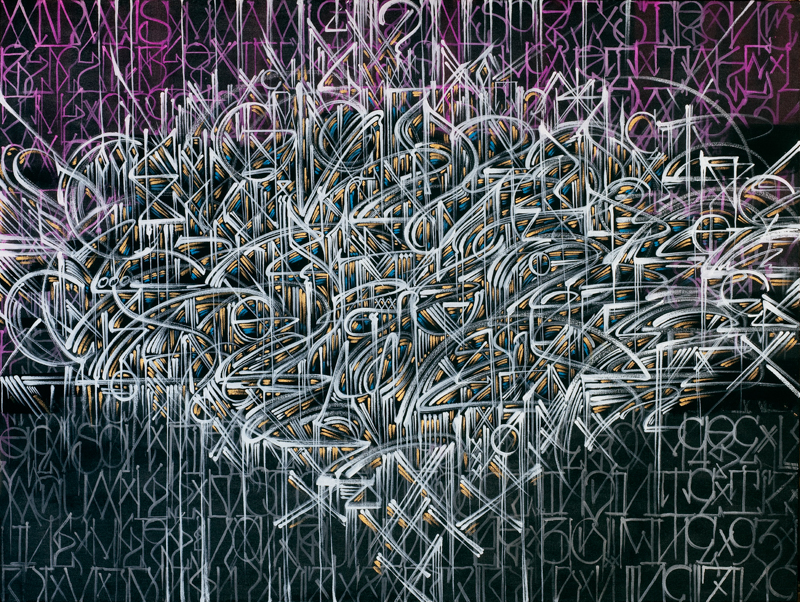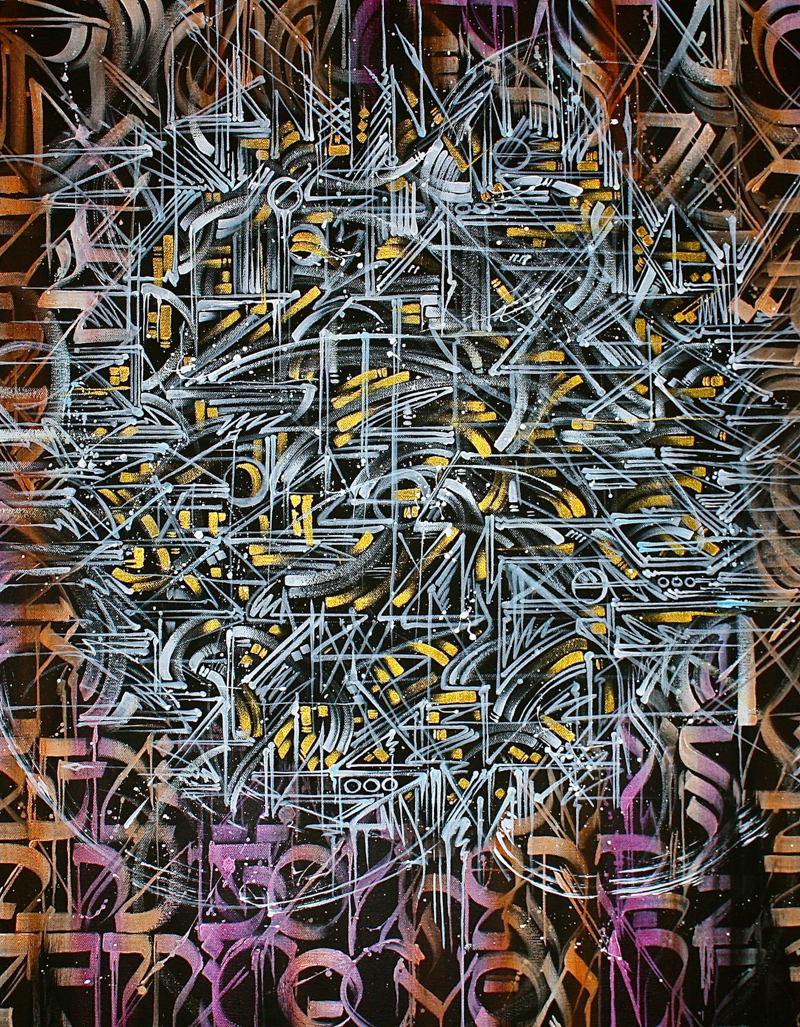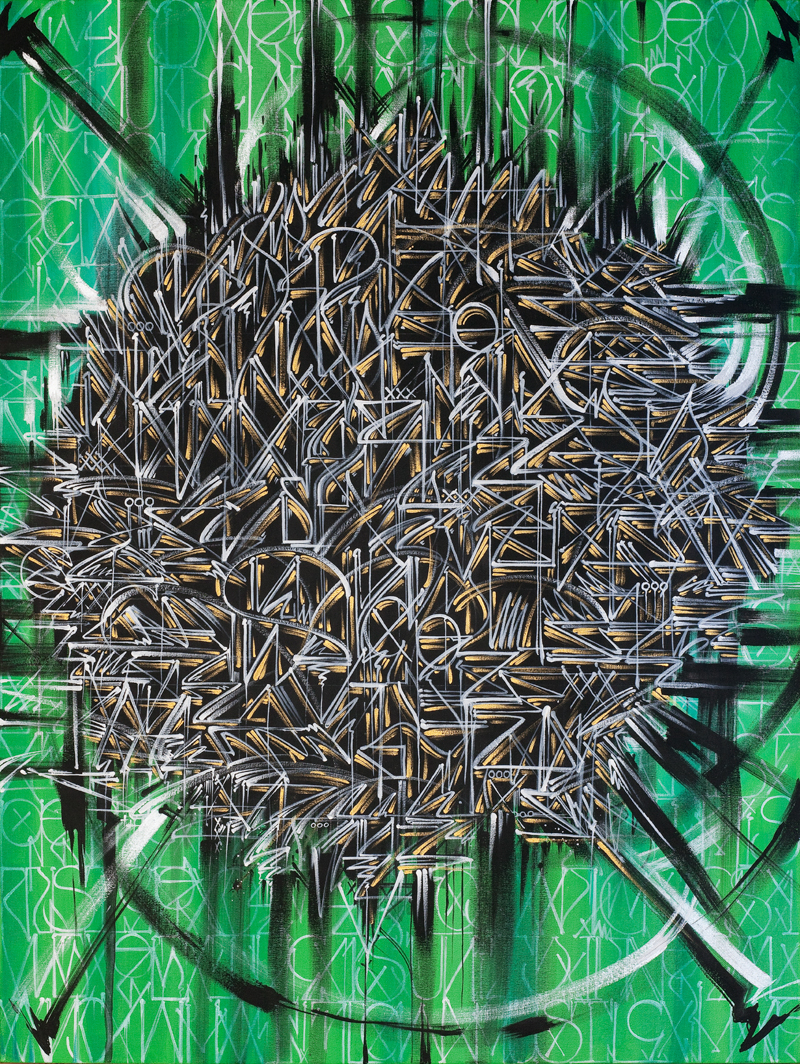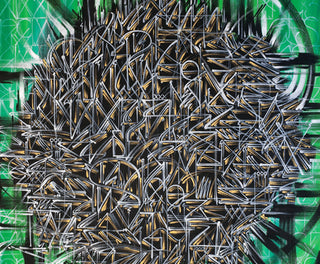In the mid-1980s, DEFER and friends—such as SINE, CRIME, PRIME, DUKE and SKEPT—pioneered a form of graffiti that was distinctly Angeleno. The style combined New York graffiti, which DEFER discovered when Style Wars aired on TV, with the placasos (roll calls) he would see in his Boyle Heights neighborhood. “We did the placasos before we saw NYC graffiti, so we naturally infused it with the more complex graffiti styles,” DEFER explains. “For example, we would make Old English letters three-dimensional. Some of our lettering was shaped like the actual placaso letters, but with an infusion of color and designs. Overall, when we were kids, everything was so spontaneous and free—in life and in art.”
DEFER has continued to incorporate hyper-stylized letters into his fine art, although his process is more rigorous now. But he uses the lessons he has learned in Jiu Jitsu to push through creative blocks and remain focused. In doing so, DEFER has found new possibilities and deeper meanings in his work, and the letter compositions have started to give way to more layered and abstract forms. “I really want to push and actually obliterate the letter structure, to enter a different realm of consciousness,” he says. “In a sense, to create my own dialect, a spiritual language so to speak.”

You grew up in Boyle Heights, where you saw placasos and murals on a regular basis. When did you discover New York-style graffiti or “graffiti art”? What did you think about it when you saw it?
As I remember, the first time I really got a glimpse of New York graffiti art was when Style Wars aired on PBS in 1983. Breakdancing was big at this time, but little was known about graffiti art in Los Angeles. Also there was the Radiotron, one of LA’s first hip-hop clubs, and there was N.Y.-style graffiti on the walls. At that time, me and my friend TAZER, better known now as Ben Baller, used to try and tag, but it was not too artistic. In the mid-1980s, SOON ONE was the first guy that I saw that was actually from New York that did whole pieces—characters, backgrounds, etc.—around the city in a major way. Honestly, seeing how evolved technically and stylistically everything in New York was, was inspiring for me and it was also mystifying how they could control the spray can the way they did to create these masterpieces especially under pressure.
You and K2S created a hybrid form of graffiti that combined the fluidity of graffiti art with the sharp angles of placasos. Did you make a conscious decision to combine what you saw on local walls with graffiti art? Or was it just a natural result?
I believe it was more of a natural result—we did and saw the placasos first before we saw NYC graffiti, so we naturally infused it with the more complex graffiti styles. For example, we would make Old English letters three-dimensional. Some of our lettering was shaped like the actual placaso letters, but with an infusion of color and designs. Overall, when we were kids everything was so spontaneous and free—in life and in art.
Besides you, who were some of the pioneers of this distinct style of graffiti that L.A. would become known for?
I would have to say SINE was really an innovator. He passed away at the age of 16, but some of his styles are unmatched to this day. Rick CRIME was really doing great work in the mid-1980s; PRIME was also. DUKE was really good—he was the first one I saw that really infused Old English and handwriting into his style. SKEPT was also a pioneer of infusing these two schools of styles, also he was really technically and artistically advanced for that time period.

What made you want to take your art from the streets to canvases? Was it a difficult transition to take your art into galleries?
It actually happened somewhat naturally. I was asked to be in a few small group shows around 2004 or 2005, but I was not really focused on art at that time. But I submitted framed drawings. I really had no expectations. But it was a whole different dynamic to see your work housed in a gallery setting. In 2007, as a student at Santa Monica College, I took an art class with this instructor named Ronn Davis, he saw my work and said something to the effect of, “This is what you should do.” I asked, “What do you mean?” He was like, “You should do this as a career.” The next class he asked me if I wanted to be in a group show in Culver City. I then had to try and create works for display. It was challenging mentally, creatively and technically to compose works for a gallery setting. Especially in making the transition from the vast expanse of a wall to a framed canvas. I had to make adjustments—but the transition went well.
What are the most common themes in your current work?
My current work really focuses on layers, abstract motion and breaking out of the letter structure. I’m not sure if that equates to a theme. Although the different processes are metaphors—the many layers represent the layers of human existence to me, the spiritual, mental, and physical. The trials and tribulations, the defeats and the victories, and so on and so forth. The abstract motion represents reaching a state of fluidity, a place where time and restriction no longer exists. Being known for my letter compositions, I really want to push and actually obliterate the letter structure, to enter a different realm of consciousness. In a sense, to create my own dialect, a spiritual language so to speak.

Who or what is your work most inspired by?
I would have to say that training Brazilian Jiu Jitsu is probably what inspires my artwork the most. It seems like it has nothing to do with the practice of visual art, but the lessons learned from Jiu Jitsu—humility, being calm in bad situations, strategy, flow, mental strength, patience and so much more—play out in my artistic process. It really helps my practice especially when I have creative blocks, or crazy deadlines—it’s like being in a bad position in Jiu Jitsu, you stay focused and find a way out. Also just facing adversity, frustration, fatigue, defeat, and all the rigors that come with it, and to push through, there is this peace and calmness in the eye of the storm, which I carry into my daily existence.
What are you working on now?
I’m gearing up for a show curated by David Brafman that the Getty is putting on at ESMoA in El Segundo. It will feature artwork by artists who were featured in the “Libre Amiquorum” (Book of Friends). This is a blackbook that was donated by Ed Sweeny to the Getty Research Institute, which features the work of 147 artists from Los Angeles. I’m also going to embark on a new series of paintings that focuses on the properties of water.

